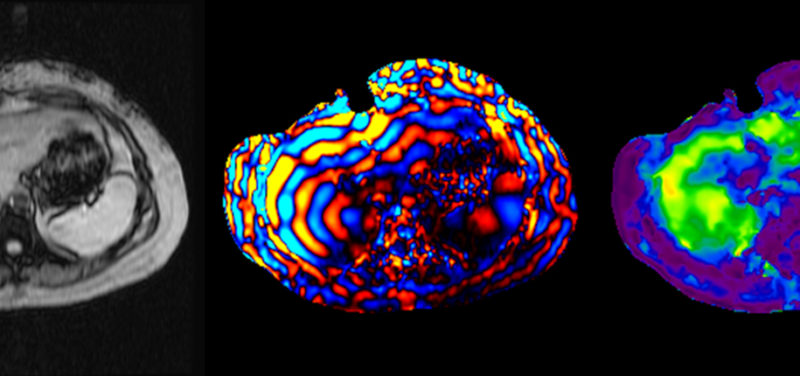

Chronic liver disease (CLD) is an important cause of morbidity and mortality and can lead to hepatic fibrosis, cirrhosis, portal hypertension, and hepatocellular carcinoma (HCC). CLD has become a major health burden in the US and around the world. Regardless of how the disease originated, when left untreated, it may lead to liver fibrosis and, if progressive, to cirrhosis. Thankfully, effective treatment methods for CLD are now available and can prevent progression of the liver disease (or even result in a possible reduction in the progress, if treated in the early stages).
Magnetic Resonance Elastography (MRE) is a non-invasive means of assessing hepatic stiffness. It has shown to give accurate readings of liver stiffness, potentially removing or reducing the need for liver biopsies. Unlike a biopsy, MRE is non-invasive and suitable for repeated use to assess disease progression and treatment response without the use of any needle sticks. Quantitative stiffness images (elastograms) of the liver can be rapidly obtained during breath-held images and readily included in any conventional liver MRI protocol or obtained as a short dedicated MRE exam.

Image: Magnetic Resonance Elastography Magnitude (a) and Wave (b) images showing illumination of waves through liver. Stiffness map (c) showing elevated liver stiffness consistent with fibrosis.
At Cincinnati Children’s, we are attempting to reduce the number of unnecessary biopsies (invasive procedures), and it is very important we measure the range of accuracy and variability of an MRE to better understand whether a measured change in stiffness represents a true biological change or measurement variability. In order to develop a measurable substance for disease evaluation, it is essential to estimate the measurement error of the technique as well as to standardize both acquisition and analysis techniques. Measurement error is commonly determined by repeatability. Repeatability represents the measurement’s precision under a set of conditions that include the same measurement procedure, operators, measuring system, operating conditions and physical location replicated over a short period of time.
In a recently published study at Cincinnati Children’s, we assessed the agreement and repeatability of MRE-derived liver stiffness measurements across two different scanner manufacturers, two different field strengths, and three different pulse sequences. After statistical analysis of our results, we found an average patient level variance of measured stiffness was 0.042 kPa with a coefficient of variation of 10.7%. In other words, for measuring liver stiffness over time and assuming no modification in hardware or software, a change of over 10.7% helps establish, with 95% confidence, that the likelihood of an observed value represents a true change.
More Information on the Topic: Liver Stiffness Measurements with MR Elastography: Agreement and Repeatability across Imaging Systems, Field Strengths, and Pulse Sequences
MRE procedures are only offered at select medical facilities throughout the country because it is a relatively new technique. This technology paired with Cincinnati Children’s drive to change the outcome has allowed us to grow in our treatment of diseases related to liver stiffness and has created opportunities for healing that were previously non-existent.
Contributed by Suraj Serai, PhD and edited by Tony Dandino, SPEC-MR QUALITY.
